Facade decor of expanded polystyrene
Domestic producer facade decoration workshop "Renaissance" is engaged in the manufacture of facade moldings made of expanded polystyrene with acrylic coating. This material is the easiest and cheapest of all possible for the facade decoration.
Our specialists will be able to quickly make the chosen option Facade decoration from this material. The total cost of products will depend on the density of the foam (there are 4 possible options and "44 sub-variants"), which, in turn, can both positively and negatively affect the life of the decor. Styrofoam with acrylic coating can serve you up to 5-10 years, if it is competently made and assembled. However, we note that all the same, the stock of longevity for articles made of polymer concrete and fiberglass fiber is twice as high.
We also note that we can make the cornices of a combined type, which can later turn into a single architectural project.
We do not live in illusions and we understand that, for example, aspen furniture can not serve as much as oak or beech furniture. It should be understood that the acrylic coating is made of water-based resin, i.e. it is rather hydroscopic and not frost-hardy.
Customer ordering this Facade decoration should clearly understand for themselves that there is a huge gap between cost and service life. What do we mean? Suppose that the facade decor of acrylic for a conditional Project costs 300,000 (three hundred thousand) rubles, and will last 5-10 years. Of fiberglass concrete exactly the same project will cost 500,000 (five hundred thousand) rubles but the service life will be calculated in decades. That is, you can lekgo rely on 30-40 years. A facade decoration of polymer concrete for all the same project will be estimated already 700000 (seven hundred) thousand rubles but the service life will exceed a century! After a while, add to this the dismantling and erection of the old and new decor, the collection and analysis of scaffolding, the services of workers, plus the feeling that you live in repair! And when everyone thought it through, felt it, let it through, weighed all the pros and cons, then you can safely order the decor knowing that you will not regret your choice!
Facade decor of foam plastic
can not be transported at subzero temperatures (suppose you bought a decor and wanted to transfer to an object, so for this you need to use insulated wagons!) Since the material becomes freezing when it freezes and can easily break and break.
The facade decor of expanded polystyrene with acrylic coating can serve you for a relatively long time, provided that the technological accuracy is kept from the production stage to the installation of both the cornice and other facade elements.
As previously stated in the article about fiberglass concrete, we remind that we work with catalogs of all companies, that is, you are not limited to the assortment of our site, but you can choose a suitable one in appearance facade decoration, and we will produce it specially for you.
One of the most demanded heat and soundproof materials. It is distinguished not only by low thermal conductivity, but also by such important characteristics as:
- wide range of operating temperatures;
- resistance to inorganic aggressive chemical media;
- low coefficient of temperature linear expansion;
- high compressive strength and bending strength;
- low indicators of vapor and gas permeability and moisture absorption;
- low weight.
The facade is insulated with extruded polystyrene foam
The price of façade polystyrene foam is one of the lowest in this class of thermal insulation materials. At the same time, it is easy to install, durable and can be used with different versions of the cladding. Many manufacturers offer EPP sheets for a facade with an L-shaped edge or an end-lock groove-ridge, which allows the installation of an insulating layer to avoid cold bridges.
A wide range of advantages and attractive characteristics from the point of view of the consumer determined the high popularity of this material, both in private and industrial and commercial construction. It is widely used for insulation of facades, socles, ceilings and roofs. Extruded polystyrene foam for the facade is highly frost-resistant, retains its quality in contact with melted and groundwater, significantly reduces heat loss, does not increase the load on the load-bearing structure of buildings.
How to choose a facade insulation foam polystyrene?
Today on sale you can find a wide range of facade extruded polystyrene foam of different manufacturers and different price category. In this variety it can be difficult to determine the ordinary consumer. To choose the right one insulation for the facade , it is necessary to pay attention to the following signs of the quality of the proposed goods:
- smooth edges;
- a uniform surface along the entire length of the sheet;
- compliance with the declared geometric dimensions and density (it can be determined by weighing the sheet);
- uniform structure over the entire thickness.
The choice of extruded polystyrene for the facade: popular brands
Since extrusion of polystyrene requires rather complicated equipment, only large and well-proven manufacturers can guarantee high quality. The most popular in our country are:
- insulation foamoplex - this brand is characterized by a wide range of thermal insulation materials, for different applications, high strength and durability, compliance with safety requirements for human health and the environment and affordable price;
- expanded polystyrene URSA - one of the most famous brands of insulating materials, is characterized by a wide range, low price, as well as impeccable quality, accuracy of geometric dimensions and high fire safety;
- EPSS Styrofoam - affordable material of high quality, the range of the manufacturer has positions for use in difficult conditions and with high loads, is highly resistant to aggressive inorganic media and a record for this material resistance to ultraviolet radiation;
Panels PENOPLEX® are a composite system consisting of heat insulating material and a decorative layer in the form of a facade tile or a protective polymer coating. This technology has been widely used in Europe and North America for many years, and in recent years has gained wide popularity in our country.
It is known that the traditional ways of protecting and warming the facade of the house require quite serious financial and time costs, as well as mandatory involvement of highly qualified specialists. The use of thermal panels makes it possible to significantly simplify and reduce the cost of this process without compromising the quality and reliability of the facade system, and also for the appearance of the building.
Advantages of PENOPLEX® for the thermal insulation of the walls of the house (private house)
- excellent structural characteristics;
- effective thermal insulation and waterproofing of walls thanks to a reliable moisture resistant heater PENOPLEX;
- minimum time for installation;
- ease and ease of use;
- absence of wet processes during installation, work in any weather and at any time of the year;
- a wide range of colors;
- significant cost savings in comparison with traditional cladding schemes.
Thermo panels on a polymer basis
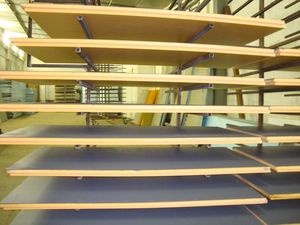
general information
Thermo panels with polymer-cement coating reinforced with fiberglass mesh are building panels based on extruded polystyrene foam. A reliable insulation and special coating, reinforced with a fiberglass mesh, give the panels unique physicochemical properties and consumer qualities.
Advantages of thermopanels based on PENOPLEX BASIC® with polymer-cement coating reinforced with fiberglass mesh
- high hydro and thermal insulation,
- a light weight,
- excellent surface adhesion,
- excellent structural characteristics,
- ease and ease of use,
- minimum prices in comparison with alternative technologies.
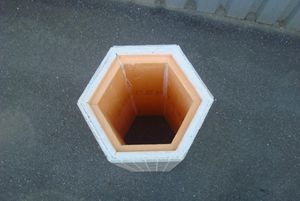
The combination of the properties described above makes it possible to use this material during construction, repair and finishing works in regions with different climatic conditions.
The most effective ways of using thermopanels with a protective polymer coating:
- insulation of facades of cottages and private houses;
- insulation of internal surfaces of modern monolithic-brick houses;
- arrangement flat roofing: both ordinary and inverse;
- heat-, hydro-, sound insulation of specialized premises (refrigerators, swimming pools, saunas, hammams, bathrooms);
- arrangement of prefabricated partitions inside the premises;
- leveling, heat, sound insulation of walls, floors, ceilings inside the premises;
- arrangement of warm floors;
- finishing and design works (decorative arches, columns, cornices and much more).
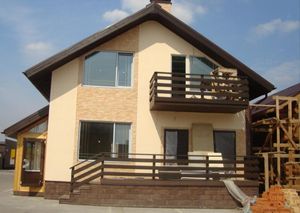
Panels are used as a thermal insulation in enclosing structures
buildings in operation:
- in non-aggressive and weakly aggressive environments;
- at an external surface temperature from -65 to + 75̊ С;
- at a surface temperature directly in contact with the panel to + 50 ° C;
- at a relative humidity of the indoor air in the room no more than 85%.
Reliable and high-quality panels with a base of panels PENOPLEX BASIC ®. Panels are available in thicknesses from 10 to 150 mm, with a single or double-sided coating. The full nomenclature includes more than 20 sizes of panels and products from them.

Instructions for use
With external insulation of the walls, thermo panels can be fixed in two ways:
- With the help of dowels of various types.
- Using a mesh sleeve and mounting foam.
External insulation of walls by thermo panels on polymer base with fastening panel dowels:
- First of all, it is necessary to prepare a heat-insulated surface, to clean it.
- Next, apply glue to the surface of the thermal panel with a plaster roller (4-6 cm wide) along the entire perimeter with a deviation from the edges of 2 to 3 cm and additionally "cakes" on the rest of the panel surface, while the area of the glued surface of the plates should be at least 40%.
- After the adhesive composition has completely dried, it is necessary to drill holes in the markings and install dowels.
- After that, glue the joints between panels of strips of alkaline mesh width of 100 mm or immediately use unique panels with the release of the mesh.
External insulation of walls by thermo panels with fastening of the panel by a mesh sleeve and mounting foam:
- Prepare, clean the surface for insulation.
- Mark the holes for the dowels at a rate of at least 4 dowels per square meter in the middle zone and 5 dowels per square meter at the edges of the wall, then make the through holes through the markings.
- Next, apply the adhesive on the surface of the thermal panel with a plaster
- spatula with a roller (width 4 - 6 cm) along the entire perimeter with a deviation from the edges of 2 - 3 cm and additionally "cakes" on the rest of the panel surface, while the area of the glued surface of the plates should be at least 40%.
- Then you should attach the panel to the wall, tightly pressing to the ends of adjacent panels. Before installing the panel, it is recommended to apply one-component polyurethane adhesive to the joints to be joined.
- After that, you need to tap the panel to ensure a snug fit against the wall surface.
- Drill the holes in the markings.
- Insert the mesh sleeve into the hole.
- Fill the inner cavity of the sleeve with foam using a mounting gun.
- After the foam has dried completely, it is recommended to remove the surplus. Mounting foam, protruding through the holes of the mesh sleeve in the gap between the wall and the panel, forms an additional stain of attachment
- To glue the joints between panels of strips of alkaline-resistant net width of 100 mm.
The architectural forms of the house and their individual elements at all times of human civilization were dictated by the presence of one or another type of building material. Strictly speaking, with the advent of new building materials The decoration of buildings, their appearance, has also changed.
There was an antique style, Gothic, modernist and so on. Architectural buildings were no longer monotonous in appearance. But the evolution of architectural styles did not stop, and in 1951 a foam plastic was synthesized.
There was a new style for architectural structures, where the facade decor of foam with a special coating played a key role at.
1 General information on the facade decor of foam
Time passed, and the facade was finished with foam with a special coating gaining popularity, and the potentialities of the main material - polystyrene foam - only increased. At the moment, many architectural buildings and their individual elements are decorated with this material.
The houses, where the decoration is made with foam plastic look uniquely charming, light and giving off some kind of romantic warmth.
Decorative entablature, made of polystyrene, finely completes the upper part of the building wall, gives the house a certain mysterious classic look, even if the building has no decorative columns (known elements of classical buildings).
The decorative facade of the building, where the decoration of the decor is made by hand with the use of foam and coating, only reinforces the already vivid impressions, especially if it has a decorative archivolt that frames the archway.
If you also decorate the columns of the building (if they are available) with a decorative curly capitulum, then the final view of the building will excite the imagination to all who look at it. It is this result that should be achieved.
In addition, on the facade decor, made of foam, you can apply decorative crumb, which will give the building an even more impressive look. Decorative chips can be made by yourself, but it is better to buy them in specialized stores.
Virtually all the main elements of the architectural building can be made of foam. Their list is large enough:
- Carved cornice;
- Porticoes;
- Architectural models;
- Rustovka socle of the building;
- Window trim;
- Elements of the console;
- Flutes and portals on.
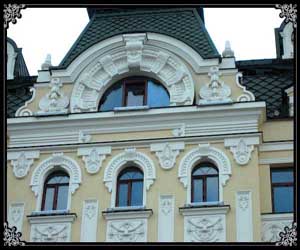
As a result, it turns out that the finishing of the facade of the house with polystyrene with a special coating looks more than attractive visually, and at the same time can be done by oneself.
1.1 Advantages of façade decor from foam
Finish made of polystyrene with a coating for facade decoration of the house with own hands has the following advantages:
- Non-molten manufacturing technology, in which expensive stencil elements are not used;
- Relatively low cost of products;
- Acceptable speed of the order;
- Huge service life up to the need for major repairs (from 5 to 7 years with advance reinforcement and with the product covering during installation);
- Literally unlimited in the size of the final product (unlimited in size and individual elements of the facade decor of the house);
- Fast and self-assembly;
- Minimum load, not leading to destructive changes, on the load-bearing elements of the house;
- Compressive strength as y;
- Non-compliance with decay or colonization processes by fungi;
- Fire resistance type "A".
In addition, styrofoam for facade decoration can be applied under any climatic conditions, including its use is possible in absolutely any regions, regardless of local climate or temperature extremes.
2 Installation process
The process of installing decorating fragments of the facade is so easy and fast that it can be done by oneself. And in this case it is important only that all the necessary products are made in strict compliance with technological standards and requirements.
As a rule, this is more concerned with the reinforcement process, that is, in simple terms, the process of strengthening the outer surface before the fixing of the necessary products in its place or between itself.
Besides, installation work This type can not be produced in autumn or winter.
First of all, a surface is prepared, on which plates or various decorative elements of the facade will be fixed. The prepared surface must be strictly level and absolutely clean.
Possible deviations should not exceed 10 millimeters per square meter. The plaster must be made without internal voids, and this is a very important point. If such voids are found, then they need to be leveled with the usual cement solution.
If in the process of this manipulation it is discovered that the facade was already originally painted, then the husk of the old paint should simply be removed.
![]()
2.1 Production technology
For the figured cutting of foam material, the so-called "string", heated to the working state, is used. The accuracy of the sketch form should be secured by the use of computer graphics, with the constant transfer of information to machine digital control.
It is for this reason that the details are adjusted to each other with the utmost precision, which is calculated in microns.
Reinforcement of various decorative elements of the facade is carried out using an acrylic glass mesh that is very resistant to alkalis, which only benefits the final material, since this mesh also increases its strength, protecting it from the effects of ultraviolet rays and possible sharp changes in the climate.
After that, adhesive mesh is added to the mesh with the help of fixative cement-cement composition. In this case, the thickness of the sputtering should be no less than 1.5 - 3 millimeters, focusing on the size of the workpiece.
As a result, visually the facade decor of foam with a coating and will be very much like a carefully plastered surface, which in fact should ideally be.
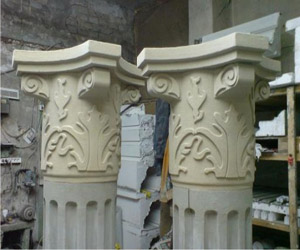
Despite the fact that the described manipulations can be done with their own hands, while having the necessary knowledge and tools necessary for carrying out this kind of work, it is better to turn to specialized companies in order to guarantee the success and efficient installation of the façade decor from the foam material.
2.2 The process of reinforcing the facade decor from foam (video)
Order EPSS - extruded polystyrene foam right now!
The company "Baulux" remains faithful to its principles, and we offer you EPS - extruded polystyrene foamit leaves no doubt about the quality and technical specifications: Styrofoam: Steeraf.
Extruded polystyrene foam - EPPS - one of the most effective modern heaters. EP is very similar to polystyrene foam, but it has a more dense and integral structure, as a result, very high compressive strength and zero hygroscopicity.
Extruded foam polystyrene: advantages
The main properties of extruded polystyrene foam include:
low thermal conductivity, frost resistance (the coefficient is much lower than that of most insulating materials, in the humid conditions the thermal conductivity changes insignificantly, which makes it possible to do without additional waterproofing);
low vapor permeability (the smallest coefficient among the materials of the group, the resistance of 20 mm of the extruded polystyrene plate is comparable to one layer of roofing coating);
absence of water absorption (the absorption of extruded polystyrene when fully immersed in water stops after 10 days and is less than 0.5% of the volume, only the top layer that was destroyed during the manufacture is filled, the water does not penetrate inside);
high mechanical strength (epps: extruded polystyrene foam does not crumble onto pellets when impacted, stretched or compressed);
resistance to ammonia, cement, animal and vegetable oils, organic and inorganic acids, caustic alkali, alcohol dyes, biodegradation;
simplicity of application (installation of EPS extruded polystyrene does not require additional cutting tools);
long-term preservation of the original characteristics (thermal insulation properties do not change after thousands of cycles of freezing and thawing, the change in thermal resistance is within 5%, in the range from 50 below zero to +75 degrees, all physical characteristics of the material remain unchanged).
Many people are primarily interested in the cost of the material and this is correct! But the real cost is inextricably linked with the quality of products. To date, there are two truly high-quality materials: Penoplex and Styrofoam. All other materials go quality at least a step below and this is universally recognized among professional builders.
We have the opportunity to supply you with high-quality Styrofoam material for a unique price for a quality material of 3,850 rubles. per m 3.
Below we present the table: the price for all the main brands of materials: Penplex, Styrofoam, Teplex.
